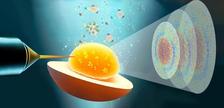Schematic illustrating the X-ray photon correlation spectroscopy experiment. (Credit: University of Siegen/ Marie Abhag Louise)
Heated egg yolk is widely used in our kitchens, in food industry and in biotechnology. However, only little is known about the out-of-equilibrium processes occurring during thermal treatment of the egg yolk’s contents leading to the well-known grainy gel microstructure. A group of researchers, headed by Christian Gutt from University of Siegen and Frank Schreiber from Tübingen University with scientists at DESY and TU Dortmund now report new insights into these processes in the journal Nature Communications. The team used coherent synchrotron radiation at PETRA III to investigate the functional contribution of egg yolk constituents’ proteins, low-density lipoproteins (LDLs – the fat molecules), and yolk-granules to the development of the grainy-gel microstructure and microscopic dynamics during cooking.
Apart from its food, biological, and also therapeutic value the diversity of proteins and high concentration of LDLs make egg yolk also an ideal candidate for studying the physics behind biologically relevant non-equilibrium processes. Most often denaturation and aggregation of proteins and LDLs are undesirable in biological systems, especially in relation to the pathogenesis of several human diseases such as Alzheimer’s disease, Parkinson’s disease, atherosclerosis, and others. Furthermore, the instability and aggregation of protein drugs, caused by deviations from optimal conditions of temperature, pH, ionic strength, etc. are one of the main challenges the pharmaceutical industry faces.
“The nanoscopic non- equilibrium processes involved in protein aggregation need to be understood on the relevant time and length scales.” explains Nimmi Das Anthuparambil lead author of the study working in Gutt’s group and at beamline P10 at DESY. The team employed a technique called X-ray photon correlation spectroscopy (XPCS) and record X-ray movies of the protein denaturation and LDL aggregation processes. “We observe that the temporal evolution of the structure of the protein gel network, the aggregation of LDLs and the microscopic relaxation rates each follow particular scaling laws, which nicely collapse onto master curves when scaling the waiting times during cooking with their respective characteristic time scales. This means that the processes/mechanism which leads to the formation of the grainy gel-microstructure is identical irrespective of the cooking temperature, but the speed of these processes depends on temperature. “, says Anthuparambil.
“These experiments make ideal use of the coherent fraction of the X-ray radiation produced at the PETRA III synchrotron” notes Michael Sprung from DESY. From th¬e large data sets the team could construct even a generic time-temperature phase diagram for the out-of-equilibrium processes during egg yolk gelation. “This diagram is impressive as it nicely illustrates the coupling of the nanoscale processes that give rise to the gel structure in a wide range of time-temperature combinations“, comments Nafisa Begam from Frank Schreiber's group in Tübingen.
Christian Gutt points out that the results of the studies financed by BMBF are based on a close collaboration between DESY and the University teams and explains “We expect our results to be relevant beyond egg yolk and that similar scaling laws will accompany a large range of denaturation phenomena and nanoscale structure formation in biologically significant dense protein systems.”
Future research from this collaboration will explore the aggregation of egg yolk proteins caused by deviations from optimal conditions of salt and pH. This could provide insights on the suitable conditions for stabilizing the proteins, which has implications for storage conditions of future protein-based drugs.
Reference:
Exploring non-equilibrium processes and spatio-temporal scaling laws in heated egg yolk using coherent X-rays: Nimmi Das Anthuparambil et al.; Nature Communications, 2023, DOI: 10.1038/s41467-023-41202-z







